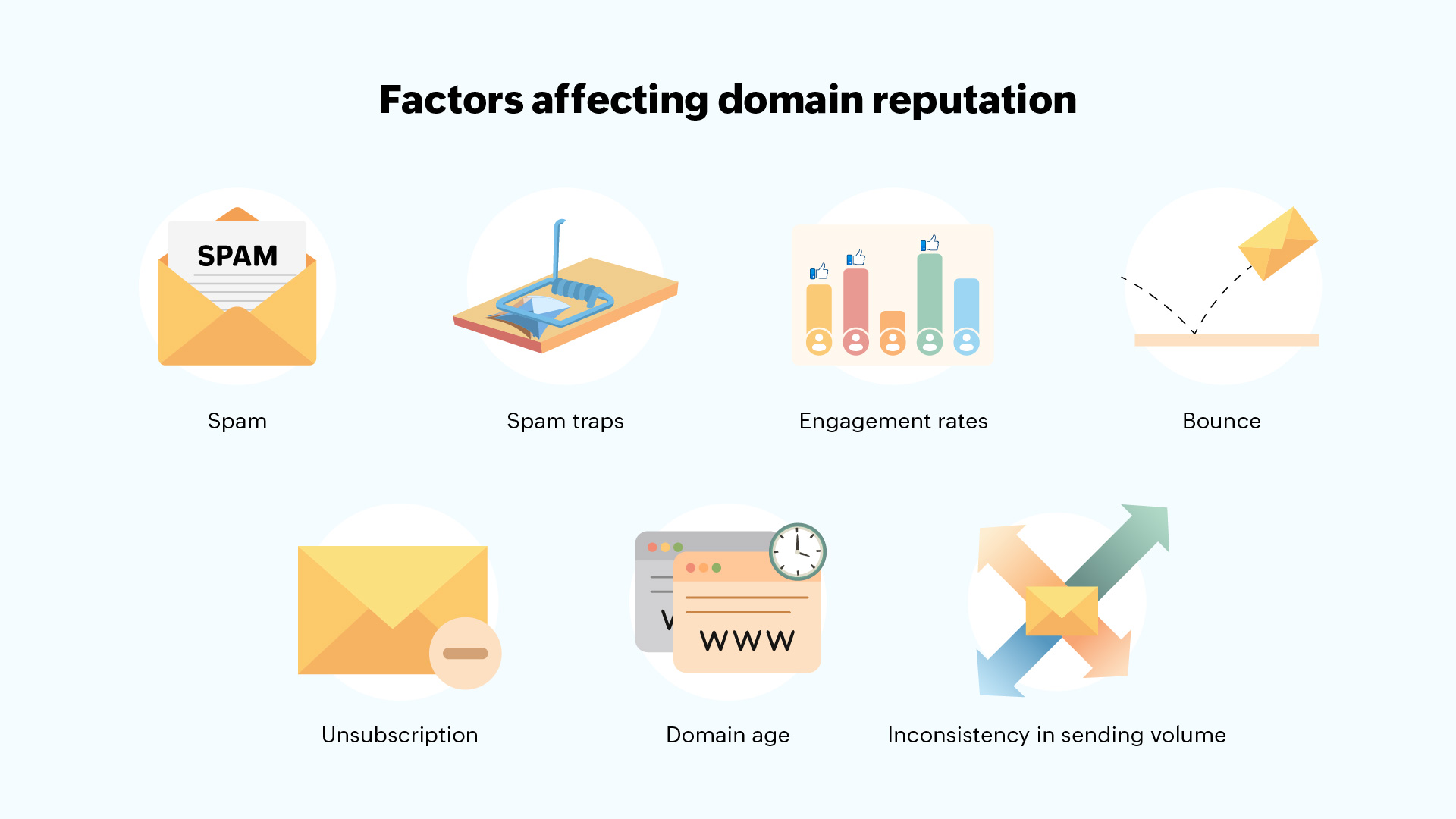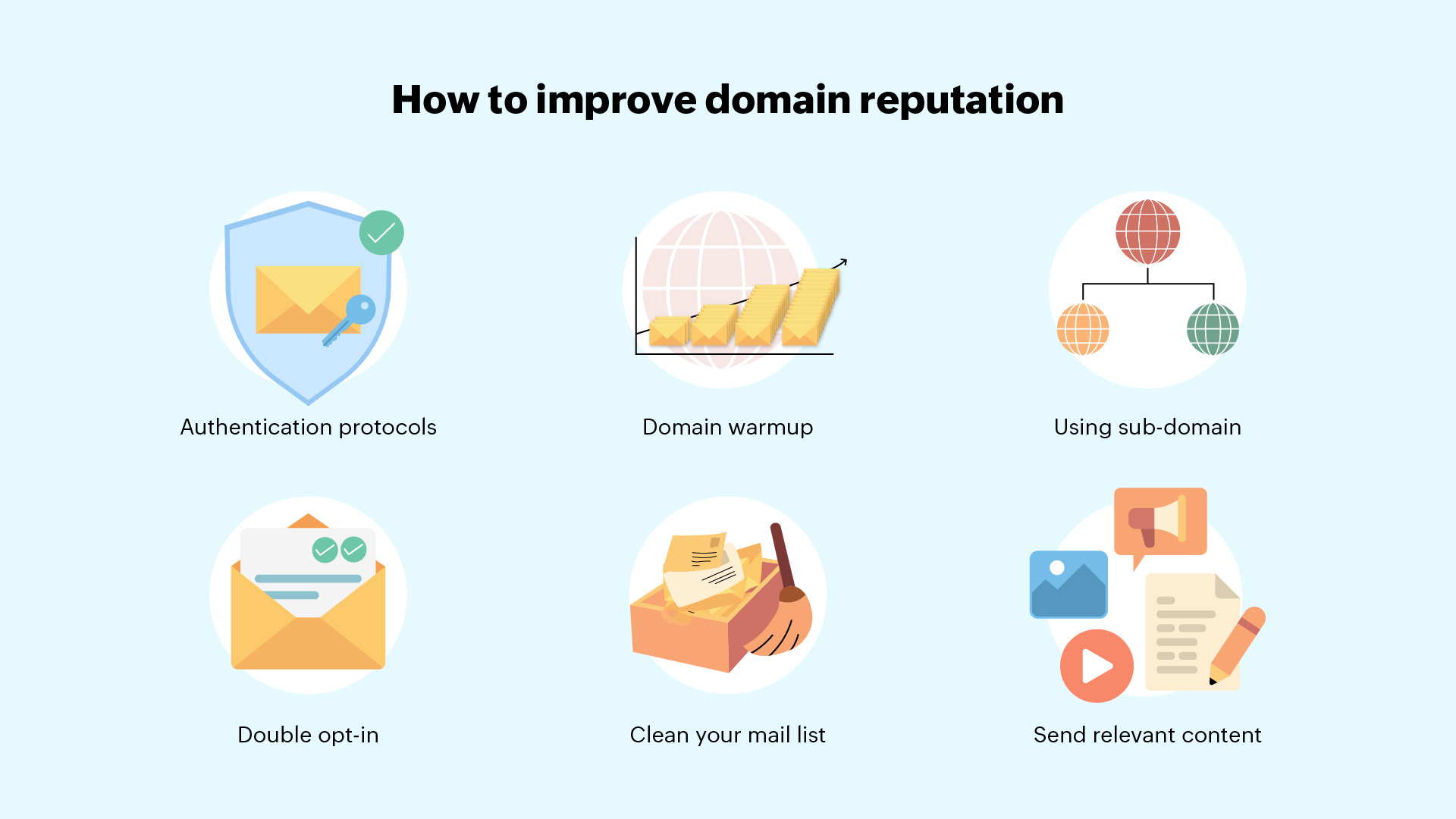How to improve domain reputation
- Published : September 29, 2023
- Last Updated : January 8, 2026
- 1.2K Views
- 7 Min Read
Introduction
Sending an email is as easy as a swish and a flick and the magic is done. At least that’s what we as senders would like to believe. But, it’s an intricate dance between protocols and privacy regulations to actually make the email reach the intended destination. A lot of work goes into crafting and sending an email. We’ve discussed the sending part in our other articles. This article will focus mainly on the deliverability aspect of your emails, one of which is domain reputation.
What is domain reputation
Domain reputation is the measure of your domain's credibility by internet service providers (ISP). A domain with a good reputation is deemed to be trustworthy, resulting in a good inbox placement of the emails. Alternatively, a domain with a poor reputation tends to have even their important emails, such as transactional emails, land in the spam folder. There is a focus on maintaining a good domain reputation.
How is domain reputation calculated
Receiving ISPs employ different algorithms to rank the sending domain's reputation.These are kept secret for the obvious reason of protecting spammers from getting their way.
However, the most common way of determining it is by tracking how the domains and their emails are treated by the recipients. Domains whose emails are constantly blacklisted or marked as spam will rank least on the scale, while domains that follow clean email practices will have a higher ranking.There are certain factors that a domain owner should consider while sending out their emails. They are listed below.
Factors affecting domain reputation
No matter how your domain's reputation is calculated, focusing on the following elements and eliminating them will ensure ranking up your domain reputation.
Spam
Your emails being marked as spam is a surefire way to reduce your domain's reputation. An occasional spam report may not seem much of a problem; however, in the long run, small instances of spam will add up to make a huge impact. This will cause issues especially when you use your domain to send transactional emails. One way to avoid this is by using a dedicated transactional email service like ZeptoMail.
Spam traps
Spam traps are email addresses that ISPs create to catch spammers. If your mailing list contains these spam traps, there’s a possibility of your domain being identified as spam, affecting your domain reputation.
Engagement rates
Engagement rates determine how well your customers are involved in your email content. They’re calculated based on two factors:
Open rates: They show how many of your recipients have opened your emails. High open rates indicate that your email content has hit all the right notes and have engaged your audience.
Click rates: Click rates indicate how many recipients have clicked on the hyperlink(s) within your email.
Making sure you engage your audience will help you keep your domain reputation high.
Bounces
Bounces, as the name suggests, are emails that have returned or bounced to the sending email address without reaching their destination. Domains that constantly send emails that bounce will be on their way to having their domain reputation reduced. There are two types of bounces:
Hard bounce: Hard bounces occur due to a permanent unavailability of the recipient. The reasons could be an incorrect email address, the recipient address being invalid, or the recipient server completely blocking email delivery.
Soft bounce: Soft bounces occur due to temporary reasons. They usually clear up and the email will be delivered to the recipient.
Refer to this article on email bounces and how you can avoid them.
Unsubscription
How many recipients unsubscribe to your emails is another indicator of low customer engagement. High unsubscribe rates show the recipient servers that your content is not helpful to your audience. This information will be a marker while determining your domain reputation.
By constantly cleaning your recipient lists and refreshing your content, you can ensure your content is helpful and relevant.
Domain age
Domain age plays a factor in deciding the domain reputation. Older domains that have been sending emails for quite some time will have a consistent activity history. Newer domains don’t have the privilege. When they send out too many emails, anti-spam filters might mistake it for a malicious domain. As a result, emails sent from this domain could be marked as spam.
Inconsistency in sending volume
Inconsistent mailing practices are typical of spammers and if, for some reason, you tend to follow the same, email providers will mistake you for a spammer. Inconsistent mailing practice may fall under the following categories:
Content: When the content of the emails you send drastically changes. Say you have been sending emails for animal products and you suddenly switch to sending emails about travel, it might be a matter of concern for the ISPs.
Volume: When the mailbox providers detect a sudden change in the volume of emails sent, or if there is inconsistency in the volume of emails sent.
Pace: When the duration at which emails are sent vary. If you’ve been following a pattern of sending two emails a week and you increase the rate to 10 emails in a week, the inconsistencies could affect your credibility.

How to improve domain reputation
Below are some of the best practices to improve your domain reputation.
Authentication protocols
By adding authentication protocols to your domains, you can give an additional layer of security and credibility to the emails you send. These protocols tell the recipients that the emails coming from a particular domain are legitimate. The three authentication protocols that are used are:
SPF: SPF record lists all of the servers that are allowed to send emails from a particular domain. When a receiving server intercepts an email, it will check to see if the sending server is listed in the SPF record. If it is, the email will be delivered, if it’s not, it will be rejected.
DKIM: DKIM is an additional security that is added to emails to ensure that the contents aren’t modified in transit. Additionally, the receiving servers also use DKIM to verify your domain's identity.
DMARC: DMARC works with SPF and DKIM to provide an additional layer of security to the emails you send. DMARC records tell the receiving server what to do with the emails that haven't cleared SPF and DKIM authentication.
This blog post will give a detailed explanation of the email authentication protocols.
Domain warmup
Mailbox owners are suspicious of domains that have a sudden spurt of email activity. They tend to associate this with malicious behaviour, which in turn will affect the domain's reputation. To avoid this, it’s recommended to gradually increase the amount of emails sent over a period of time. This process is called domain warm-up.
By warming up your domain, you’ll be able to increase your domain's reputation gradually. The warm-up process takes place at least over a course of two months.
Using sub-domains
This method holds relevance especially in the case of transactional emails. Say you own a business that sends both transactional as well as marketing emails from your domain. Marketing emails, such as newsletters and promotional campaigns, may be marked as spam. We’re aware that spam emails will affect the domain reputation. When the same domain is now used to send transactional emails, the receiving server may perceive those emails also as spam and reject them. Nobody wants their transactional emails being sent to the spam folder or rejected entirely.
By having a separate subdomain for your transactional emails, you can rest assured that your subdomain will have a good reputation. Even if the domain you use for your campaigns gets a hit in terms of deliverability, this won’t affect the domain you use for your transactional emails. Further, you can opt for a dedicated email service like ZeptoMail for your transactional emails and use this subdomain to ensure better deliverability.
Double opt-in
Double opt-in is the process of getting an additional confirmation from a user who signs-up for your marketing services. This helps you maintain a quality mailing list, where you have only those customers who are genuinely interested in your services. Double opt-in is also a foolproof method of avoiding spam traps and incorrect email addresses in your mailing list.
Clean your mailing list
As your client list grows, it’s essential to occasionally eliminate email addresses that are either outdated or causing bounces. Maintaining a hygienic list will have a direct impact on your domain reputation. Depending on your sending pace and volume, you can be on constant look out for contacts that have zero to low engagement with the emails you send. Pruning your list every two to six months will help you avoid the impending spam and protect your domain reputation and deliverability.
Send relevant content
The content you send will have an indirect impact on your domain reputation. When your email content is irrelevant and unhelpful, customers tend to mark them as spam. Gauging your buyer's persona and sending them relevant information will not only reduce spam instances, but also help retain your customers.

Wrapping up
Domain reputation is one of the key factors for determining deliverability. Deliverability is crucial when your domain is used to send transactional emails. Apart from using dedicated subdomains, you can also use a separate email service for your transactional emails. A service like ZeptoMail not only helps you with this, but also ensures smooth email delivery.
If you use ZeptoMail for your transactional emails, you can improve your deliverability using the guidelines mentioned here. By following clean mailing practices and constantly updating your recipients' list, you will be well on your way to improving your domain reputation.


